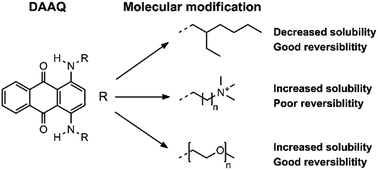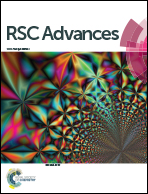Enhancing the solubility of 1,4-diaminoanthraquinones in electrolytes for organic redox flow batteries through molecular modification†
Abstract
1,4-Diaminoanthraquinones (DAAQs) are a promising class of redox-active molecules for use in nonaqueous redox flow batteries (RFBs) because they can have up to five electrochemically accessible and reversible oxidation states. However, most of the commercially available DAAQs have a low solubility in the polar organic solvents that are typically used in RFBs, in particular when supporting electrolyte salts are present. This significantly limits the energy densities that can be achieved. We have functionalized the amino groups in the DAAQ structure with three types of chains, namely alkyl chains, cationic alkyl chains and oligoethylene glycol ether chains, and measured the solubility of these derivatives in various organic solvents by quantitative UV-Vis absorption spectroscopy. The DAAQ derivatives with higher polarity exhibit a significantly higher solubility in commonly used organic electrolytes in comparison to apolar derivatives. Cyclic voltammetry was used to assess the viability of the DAAQs as redox-active species for RFBs. Although the cationic DAAQ derivatives have an enhanced solubility in the electrolytes, the cathodic redox reactions have a poor reversibility, most likely due to an internal decomposition reaction of their reduced forms. The oligoethylene-glycol-ether-functionalized DAAQs are the most promising compounds for use in organic RFB electrolytes because they have the optimal combination of high solubility and a high reversibility of the redox couples.

- This article is part of the themed collection: Recent advances in redox-flow batteries


 Please wait while we load your content...
Please wait while we load your content...